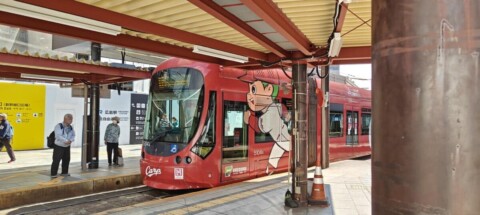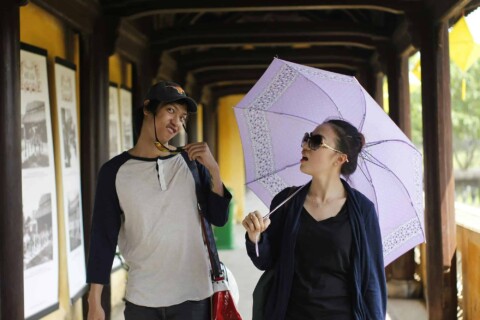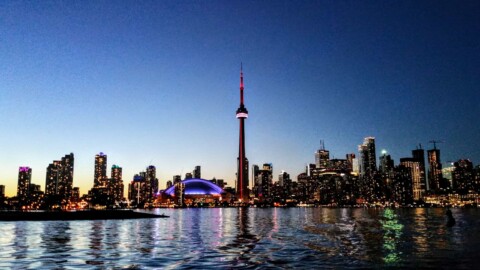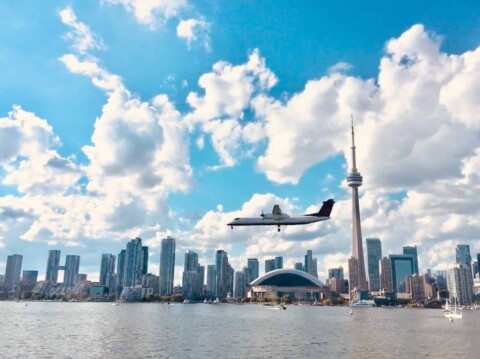There’s a peculiar ache that settles in your chest as the plane descends into Pearson Airport. The city sprawls beneath you, familiar yet suddenly foreign, as if you’re seeing it for the first time through different eyes. You’ve just returned from wandering cobblestone streets in Prague, savoring café culture in Amsterdam, or marveling at the efficient public transit in Bangkok. And now, stepping back into your Toronto life, everything feels… diminished. I call it the bittersweet return.
This isn’t just homesickness in reverse. One poll found that 1 in 5 Americans experience post-vacation depression after every trip, and a National Alliance on Mental Illness survey found that 64% of participants had experienced post-holiday blues. But what researchers don’t capture in these statistics is the deeper existential shift that happens when travel peels back the layers of our assumptions about home.
When Rose-Colored Glasses Shatter
Travel has a way of stripping away the comfortable illusions we maintain about our daily lives. In Barcelona, you watched strangers help an elderly woman with her groceries without being asked. In Costa Rica, you experienced a slower pace where conversations weren’t rushed, where people actually looked at each other when they spoke. In Venice, despite the crowds, there was a collective reverence for shared spaces that felt almost sacred.
Then you come home to Toronto.
Suddenly, you notice things that were invisible before: the way people push past each other on the subway without acknowledgment, the aggressive honking in traffic jams, the general sense that everyone is too busy, too important, too stressed to extend basic courtesies. The contrast is jarring. In Amsterdam, cyclists share the road with a fluid choreography of mutual respect. In Toronto, bike lanes become battlegrounds where drivers and cyclists wage daily wars over inches of asphalt.
It’s not that Toronto is uniquely terrible—it’s that travel has recalibrated your baseline for human decency. You’ve seen how people can live differently, treat each other differently, and move through the world with more grace. The return home forces you to confront an uncomfortable truth: much of what you accepted as “normal” was simply what you were used to.
The Cleanliness Revelation
You thought Toronto was clean—until you walked through the spotless streets of Tokyo, where finding a public garbage bin is nearly impossible yet litter is virtually nonexistent. In Thailand, despite the humidity and density, the respect for shared spaces was evident in the careful maintenance of temples and markets. Even New York, for all its gritty reputation, surprised you with its park systems and the way communities come together for neighborhood cleanups.
Walking through downtown Toronto after these experiences, you notice the cigarette butts ground into the sidewalks, the overflowing garbage bins that stay that way for days, the general air of neglect that hangs over public spaces. The TTC stations, which once seemed acceptable, now feel shabby compared to the gleaming efficiency of Prague’s metro or the artistic beauty of Mexico City’s subway murals.
This isn’t about holding Toronto to impossible standards—it’s about recognizing that cleanliness and care for public spaces is a choice, a reflection of collective values. When you’ve seen cities where taking pride in shared environments is the norm rather than the exception, Toronto’s casual relationship with urban maintenance becomes harder to ignore.
The Soul Drain of Gentrification
Perhaps nothing hits harder than returning from neighborhoods with centuries of character—the narrow alleys of Bangkok’s old quarter, the bohemian cafés of Prague’s artistic districts, the family-run tapas bars in Barcelona that have served the same families for generations—only to walk through Toronto’s increasingly sterile landscape.
The statistics tell the story: incomes in gentrified neighbourhoods climbed by an average of 53 per cent, whereas across the city as a whole incomes increased much less dramatically. Gentrification has affected more than 36 percent of prewar inner-city neighbourhoods, where affordable housing has traditionally been located. But numbers can’t capture the loss of soul that comes with this transformation.
Where once there were quirky independent bookstores, there are now chain pharmacies. Where families gathered in community centers that reflected their cultural heritage, there are now expensive condos with names like “The Residences at Wherever” and “Metropolitan This-or-That.” The mom-and-pop restaurants that gave neighborhoods their flavor have been replaced by trendy spots where a sandwich costs $18 and the staff barely looks up from their phones.
You remember the family-run pension in Barcelona where the owner invited you to join their Sunday dinner, or the street vendor in Bangkok who remembered your order after just two visits. These weren’t tourist experiences—they were glimpses into communities where people have roots, where businesses grow from relationships rather than profit margins, where change happens gradually rather than through aggressive displacement.
Toronto’s rapid gentrification has created a city that feels increasingly like a collection of lifestyle brands rather than a living, breathing community. The speed of change has been breathtaking: a quantitative analysis revealed a grouping of 168 census tracts (36%) in Toronto that consisted of a significant influx of creative industries and had a significant decrease of Black residents from 2006 to 2016. This isn’t just demographic shift—it’s cultural erasure.
The Entitled Behavior Epidemic
After experiencing the quiet courtesy of Japanese culture, the warm hospitality of Costa Rican communities, or the sophisticated civility of Parisian social interactions, Toronto’s behavioral norms can feel jarringly entitled and inconsiderate.
You notice it everywhere: the person who holds up an entire subway car while they slowly finish a phone conversation at the doors; the drivers who treat pedestrian crossings as suggestions; the restaurant patrons who snap their fingers at servers; the general assumption that personal convenience trumps collective consideration.
In Amsterdam, you watched people queue patiently and actually apologize when they accidentally bumped into someone. In Prague, public transportation was a shared space where people actively tried to make the experience pleasant for everyone. Even in the supposed chaos of Bangkok, there was an underlying flow of mutual awareness and respect.
The contrast makes Toronto’s casual rudeness stand out in stark relief. It’s not malicious—it’s the thoughtlessness that comes from a culture that prioritizes individual success over collective well-being. But once you’ve experienced alternatives, it becomes impossible to unsee.
The Numbers Behind the Blues
The psychological impact of this cultural whiplash is real and measurable. Money is the #1 cause of post-vacation blues, cited by 40% of respondents, but the deeper issues often stem from the life dissatisfaction that travel can illuminate. Post-vacation blues may result in tiredness, loss of appetite, strong feelings of nostalgia, and in some cases, depression.
For Toronto residents specifically, the return can be particularly challenging given the city’s rapid changes. Housing costs have skyrocketed, community connections have weakened, and the pace of life has accelerated to unsustainable levels. When you’ve just experienced cities where work-life balance isn’t just a buzzword but a lived reality, returning to Toronto’s grind culture can feel suffocating.
Finding Your Way Forward
The good news is that post-travel depression doesn’t have to be permanent, and the insights you’ve gained don’t have to turn into chronic dissatisfaction. Here are practical strategies for channeling your travel awakening into positive change:
1. Create Micro-Communities
Since Toronto’s scale can feel impersonal, focus on building smaller networks. Seek out neighborhood groups, hobby communities, or volunteer organizations. In many ways, you can recreate the intimacy you experienced in smaller places by intentionally cultivating local connections.
2. Become an Agent of Change
Instead of just lamenting Toronto’s problems, become part of the solution. Join local community organizations, attend city council meetings, or start small initiatives in your neighborhood. The civic engagement you admired in other cities often comes from residents who decided to care actively rather than passively.
3. Import the Best Practices
Bring elements of the cultures you admired into your daily life. Practice the courtesy you experienced abroad, support local businesses the way you did when traveling, and treat your own neighborhood with the curiosity and respect you showed foreign places.
4. Develop Cultural Bridges
Seek out Toronto’s diverse cultural communities. The city’s strength lies in its multiculturalism—you can experience elements of Bangkok’s street food culture, Prague’s artistic scene, or Barcelona’s café life right here, if you know where to look and how to engage authentically.
5. Plan Meaningful Returns
One long-term study found that workplace policies allowing 10 days of paid vacation leave were associated with a 29 percent drop in depression risk among women. Regular travel doesn’t have to mean expensive international trips—even exploring different parts of Ontario or taking weekend trips to Montreal can help maintain that sense of discovery and perspective.
6. Practice Intentional Living
Travel forced you to be present and notice details. Maintain that awareness at home. Walk different routes, try new neighborhoods, and approach familiar places with fresh eyes. The Toronto you think you know completely might surprise you.
7. Address the Deeper Questions
Sometimes post-travel blues are your psyche’s way of telling you that significant changes need to be made. As one travel blogger realized, the unhappiness wasn’t just about vacation ending—it was a signal to quit a corporate job and pursue teaching abroad. Don’t ignore persistent feelings of dissatisfaction.
The Larger Context
Toronto’s challenges aren’t unique, and they’re not insurmountable. Cities around the world are grappling with gentrification, cultural change, and the balance between growth and community preservation. What your travel experience has given you is perspective—both the sadness of recognizing problems and the hope that comes from seeing alternatives.
The key is channeling that perspective into engagement rather than detachment. The very fact that you can see Toronto’s shortcomings means you’re also capable of envisioning and working toward its potential. The cities you admired abroad didn’t become great by accident—they evolved through the efforts of residents who cared enough to demand better and work toward it.
Your post-travel sadness is real, but it’s also a form of awakening. Use it as fuel for creating the kind of community you want to live in, right here in Toronto. The city may have lost some of its soul to rapid change, but souls can be rebuilt—and it starts with residents who remember what authentic community feels like and refuse to settle for less.
The plane landed, the vacation ended, but your expanded perspective on what’s possible remains. That’s not a burden—it’s a gift, both to yourself and to the city you call home.
Related Reading:
- Post-vacation blues – Wikipedia
- Post-Vacation Depression: About, Prevention, Overcoming – Healthline
- How To Deal With Post-Vacation Depression or Sadness – The Girl Who Goes
- One of Toronto’s last affordable neighbourhoods is no longer affordable – CBC Radio
- Neighbourhood Change Research Partnership on Gentrification








